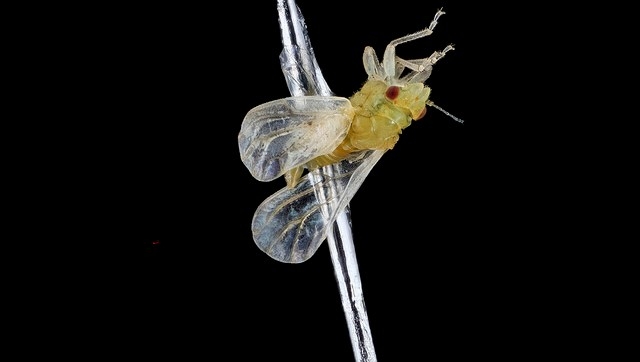CLas-positive Asian citrus psyllid found in commercial grove in Pauma Valley, San Diego County
An Asian citrus psyllid (ACP) sample confirmed positive for Candidatus Liberibacter asiaticus (CLas) – the bacteria that causes Huanglongbing (HLB) – was collected from a commercial citrus grove in the Pauma Valley area of San Diego County. This confirmation marks the first CLas-positive ACP found in a commercial grove in San Diego County and only the second grove detection in California.
The ACP sample was collected during a routine commodity survey conducted by Citrus Pest and Disease Prevention Division (CPDPD) staff. Five adult psyllid samples were pooled and tested for CLas, resulting in confirmation of the bacteria by Citrus Research Board's Jerry Dimitman Laboratory, and later verified by the U.S. Department of Agriculture's (USDA) Animal and Plant Health Inspection Service (APHIS).
An expansion of the HLB quarantine zone in San Diego County will not be established as a result of the CLas-positive ACP detection and CPDPD staff are swiftly conducting intensive surveys and collecting samples per the ACP/HLB Action Plan from the perimeter of all commercial groves and residential HLB host plants that are located within a 250-meter radius around the find.
While treatment is not mandatory as a result of the detection, all growers within 250 meters of the find site will be notified by their local Grower Liaison and encouraged to apply insecticides to all HLB host material within the designated area with materials recommended by the University of California (UC).
It is more crucial than ever that we prevent HLB from potentially impacting commercial citrus groves by working to eradicate ACP populations now. The cost to manage the ACP is far less than any potential costs or loss to the industry should HLB take hold in our commercial groves and throughout our state.
Currently, the best way to prevent HLB from infecting California's citrus groves is to stop the spread of the ACP. To do so, we must restrict its movement and suppress existing psyllid populations. It is critical to follow best practices and review recommendations from the UC on how to protect commercial citrus groves from HLB. Regulations are in place to help prevent the spread of the deadly pest and disease. All growers, packers, haulers and nurseries must comply with all California Department of Food and Agriculture (CDFA), county and federal regulations, including quarantines.
Growers in San Diego County may contact their local Grower Liaison Sandra Zwaal, the County Agricultural Commissioner's office or the CDFA Pest Hotline at 800-491-1899 for additional information. If you see or suspect ACP or HLB symptoms in your grove, please notify the CDFA .
HLB Quarantine Update
As of July 8, a total of 3,546 trees and 443 ACP have tested positive via PCR for the bacterium that causes HLB. Trees that test positive are treated for ACP and removed, and the HLB quarantine is expanded. Additional ACP treatments and HLB detection surveys are conducted on a recurring basis to remaining citrus within 250 meters of each detection. Counties where HLB has been detected via PCR testing are Los Angeles, Orange, San Diego, Riverside, San Bernardino and San Diego. To see a map of the current HLB quarantine areas, and other details of locations and numbers of HLB detections, please visit maps.cdfa.ca.gov/WeeklyACPMaps/HLBWeb/HLB_Treatments.pdf.
For information on regulatory and treatment requirements growers can expect when HLB is detected in or near your citrus grove or packing house, please refer to CDFA's Information for Citrus Growers/Grove Managers, Action Plan for ACP and HLB or this summary flier.
Additional ACP/HLB Resources
- New and improved CDFA Citrus Division website: https://www.cdfa.ca.gov/Citrus/
- General ACP/HLB
o Information on the state ACP/HLB program including maps, quarantine information, and a signup option for email alerts: citrusinsider.org/
o Biology of ACP and HLB, detection maps and recommendations for monitoring, eradication and management: ucanr.edu/sites/acp/
o UC IPM recommendations for ACP
o Web-based map to find out how close you are to HLB: ucanr.edu/hlbgrowerapp
o Video on Best Practices in the Field, available in English and Spanish
- Research
o UC Ag Experts Talk presentations on management of various citrus pests and diseases are available for viewing here and here on YouTube.
o Summaries of the latest research to combat HLB: ucanr.edu/sites/scienceforcitrushealth/
o Science-based analyses to guide policy decisions, logistics, and operations: www.datoc.us
- Regulatory/Quarantine
o Sign up for program updates from the Citrus Pest and Disease Prevention Division at www.cdfa/signup-email-updates.
o Regulatory requirements for moving bulk citrus: Information for Citrus Growers
o Summary of regulatory requirements in the event of an HLB detection in commercial citrus: citrusinsider.org/Regulatory-Flyer